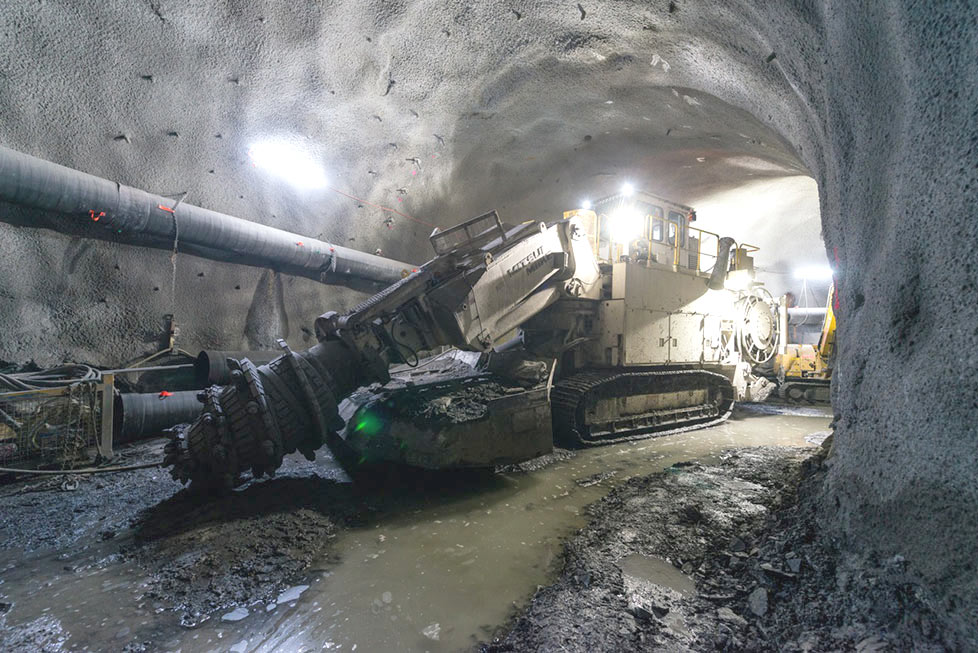Roadheader solutions in focus May 2017
Tunnel excavation using roadheaders is widespread and popular due to the high precision and relative cost effectiveness of mobilising the equipment and especially when dealing with soft to medium strength rock, as the equipment is able to excavate without weakening the surrounding structure. There are projects now that prefer, if not stipulate, the use of roadheaders due to the high cost of operating TBMs and for projects on which drill+blast is restricted, especially in urban areas or below buildings, or wherever the danger arises of damage due to blasting shock waves.
Cost factors are increasingly prevalent when choosing the tunnel excavation method and for excavation of rock of less than 100 MPa, tunnelling with a roadheader can provide cost savings when compared also to drill+blast. The other significant advantage of a roadheader is that its use is continuous. The material is cut, it falls down at the face, is picked up by the loading mechanism, transported from the machine and hauled away. Drill+blast, by comparison, is discontinuous. The face is drilled, the explosives loaded, charges set, then the material needs to be loaded and transported. TBM operation is also most usually discontinuous with excavation and segment lining build possible but rarely simultaneous and main-beam TBMs interrupted to reset the grippers.
Increasingly roadheaders are providing a flexible, mobile, safe, and environmentally friendly option, with the ability to excavate various tunnel sizes, shapes, and types. As tunnel excavation by roadheader becomes more popular, the global market has become dominated by two companies: Antraquip from the USA, and Swedish company, Sandvik Mining and Rock Technology, but they are not the only companies servicing this buoyant market, with many established and new companies providing equipment that is bound to keep the big two on their toes.
Born in the USA
Founded in 1985, Antraquip manufactures roadheaders that are of an advanced design, and deliver powerful rock cutting capabilities. They come in a variety of sizes, covering the weight class of between 13 – 80 tonne. Being electro-hydraulically powered, the machines emit no fumes and offer interchangeable cutter heads that are customized for each project. Their ability to excavate without causing harmful vibrations is highly valuable for both environmental and safety reasons.
The Antraquip range includes the AQM 50, which weighs 13 tonne and is claimed to be the narrowest roadheader available. It is suited to projects where size and operating weight are major issues. The other roadheaders in the Antraquip product line range from the 25 tonne AQM100 up to the impressive 85 tonne AQM260.
All the roadheaders share similar features and capabilities being capable of cutting hard rock economically and using an integrated high pressure pick flushing system, which delivers improved levels of operational safety and pick life. Additionally the low rotation speed of the roadheader boom and the high installed power ensures minimum dust emissions, while low ground pressure crawler tracks and no movement of crawler chains during sumping lead to limited deterioration of the working invert.
Rock properties affecting roadheader development
The use of roadheaders is often limited by the rock properties. With this in mind, Sandvik Mining and Rock Technology (SMRT) has used some of the latest technological developments to provide tunnellers with roadheaders that will economically excavate rock with compressive strengths of up to 130-140 MPa.
Also powered electro-hydraulically, the roadheaders emit no fumes, and come equipped with state of the art profile control, an automatic sequence control system and online data processing possibilities.
The roadheader range is based on the MT-series that comprises four models from the 57 tonne MT360 to the 135 tonne MT720. They are all equipped with powerful, geometrically optimized transverse cutter heads, which are proven to provide efficient cutting performance in a wide range of rock formations. Transport tunnels, shaft sinking, rehabilitation of existing tunnels and excavation of underground caverns, are just a few applications where these machines have successfully demonstrated their great flexibility.
Although the range is said to share many common features, as well as a design philosophy, the MT520 model is claimed to be a new concept roadheader in the 100 tonne class. It is based on easily interchangeable modules, making the MT520 basic machine easy to adapt for a large range of applications. An 8m cutting reach module makes this machine suitable for large road tunnels, The full cutter-boom motor power of 315kW is available for both the transverse and inline cutter heads, and an integrated dust extraction system provides a healthy work environment.
Eastern promise
While the roadheader market has been dominated by the American and Swedish manufacturers, Chinese and Japanese manufacturers have not been slow to develop their ranges of roadheaders.
The Mitsui Miike Machinery Co Ltd launched its first roadheader, the first roadheader to be manufactured in Japan and at 15 tonne, back in 1968. Since then, Mitsui Miike roadheaders have become more powerful and heavier to satisfy developing customer requirements. Its premier model, the SLB-350S, has a 350kW cutting boom motor and weighs 120 tonne, making it one of the largest in the world.
All models in the Mitsui range have been developed with efficient tunnelling and high-speed soft rock excavation key to the design ethos. Most are deemed suitable for diverse geological conditions and in rock strengths up to 100 MPa, with the MRH-S300 capable of excavating rock strengths of up to 130 MPa.
Since its formation in 1989, the Chinese SANY Group has grown to include five industrial complexes in China. It also has an R&D and manufacturing centre in the United States, Germany, India, and Brazil, and now employs about 40,000 people in more than 150 countries. As with many Chinese equipment manufacturers, SANY has placed an emphasis on R&D, with an investment of between 5 and 7% of annual sales in R&D. This has allowed the company to develop a range of roadheaders aimed at the heavier end of the market. Its EBZ260H roadheader weighs in at 91 tonne and is equipped with a cutting boom power of some 260 KW. It also possesses a three stage vibration dampening system, integrated dust extraction and wireless remote control operation.
The Xuzhou Construction Machinery Group (XMCG) is now the largest construction equipment manufacturer in China and the 5th largest in the world. As such, it comes as no surprise that the company now manufactures an impressive product line of roadheaders ranging in weight from 23 tonne to 120 tonne. Its heavier duty equipment is designed to work through hard rock. The flag ship 120 tonne EBZ 320 comes with an inline cone cutting head, purpose designed for hard rock, which possesses a stronger drilling force and an optimized pick structure for delivering what is claimed to be excellent rock breaking capacity and a low consumption rate of picks.
Other features found on the range include a spraying system for reducing the effects of dust that includes a three-layer water curtain partition. The hydraulic system delivers consistent power and load sensitive control, which ensures that the roadheaders are energy efficient and maximise the environmental credentials of the product range.
European engineering expertise
As well as the more famous names, there are European manufacturers who have also developed a reputation for equipment excellence, drawing on long histories of engineering know-how.
German company Deilmann-Haniel Mining Systems (DHMS) has a proud 125-year history. Currently the DHMS roadheader family consists of three weight classes ranging from 61 tonne to 130 tonne, and cutting boom power that ranges from 200 kW to 400 kW.
The new, DHMS compact design roadheaders of the lower and middle weight class have been adapted specially to the challenges posed in coal mines and as applied to civil projects. Its 60 tonne – 130 tonne roadheaders combine high machine weight and an automatic stabilisation system.
All DHMS roadheaders are operated using separate radio control consoles that offer reliable, accurate and ergonomic handling. An automatic profile display and recording system is used to maintain the accuracy of the face profile, while all relevant status conditions are displayed and monitored by an on-board data acquisition and diagnosis unit that also relays the signals to the control room and to an online data system.
IBS, Industriemaschinen-Bergbau-Service, has been producing equipment for the tunnelling industry since 1971. Its roadheaders come in the 30-50 tonne range and are fitted with state of the art control and powertrain systems delivering what is said to be enhanced performance and efficiency with improved ease of maintenance. These new features also enable the machinery to be used in conjunction with the company’s recently developed outburst management package (OMP) enabling for what is claimed to be the first time a roadheader that can be operated in safe man-free mode from more than 200m away.
Another German manufacturer is the BBM Group, which was established in 1990 and specialises in purpose-built equipment for the mining and tunnelling industries. Its roadheaders range from 55 tonne to 100 tonne models, with features designed to ensure efficient, productive and safe excavation. Cutting power ranges from between 160kW to 300kW (with an option for 400kW on its 100 tonne model) and can be fitted with distinct features to suit specific applications.
Interesting features on the equipment include an articulated cutting boom arm, which is equipped with two cutting heads fitted with round shaft bits. This may be swivelled horizontally and vertically enabling selective excavation with dimensionally accurate cutting of the heading profile. Targeted water spraying of the cutting heads provides efficient cooling of the cutting bits, thereby reducing their wear and the production of dust. Cutting performance has recorded the reliable rock excavation of compressive strengths up to 120 MPa, achieved in continuous operation and with reserves in the robust cutting boom should the rock become harder. The electro-mechanical cutting drive is water-cooled and, if required, may also be equipped with its own water air cooling circuit.
An effective but different solution
Herrenknecht AG, a company that has become synonymous with TBMs, also manufactures a range of shield-mounted roadheaders that are different to the norm, but just as effective. The partial-face shielded machines present an economical solution in homogeneous (and almost) stable ground conditions with little or no groundwater.
The universal shield-mounted boom can be fitted with different cutting tools from a shovel, a ripper tooth or a hydraulic jackhammer, and a roadheader boom can be fitted for when rock of 80 MPa or more is encountered. The excavated material is transported by belt or chain conveyors to the conveying system located at the rear of the operation.
The operator of a partial-face shield-mounted boom machine is located just a few metres from the open tunnel face allowing for precise control of excavation and swift reaction to changes in the ground conditions. This is of direct benefit during the excavation and removal of large boulders or obstructions without having to create additional shafts. Direct visual contact with the geology is also seen as an advantage for the steering process.
The Herrenknecht shaft boring roadheader (SBR) was developed specifically for mechanized sinking of blind shafts in soft to medium-hard rock. The SBR has been equipped with a roadheader boom and a rotating cutting drum that enables the cutting of variable shaft diameters from 8m to 12m. The system delivers higher occupational safety compared to conventional methods.
Horses for courses
TBMs, drill+blast and roadheaders, each method has its pros and cons, thereby enabling tunnelling contractors to use the method best suited to budget, rock, local operating conditions and a host of other factors. Given the broad range of roadheaders available on the market, from all corners of the globe, there is little doubt that this method of tunnelling offers many advantages, helping to ensure that the selected method matches the geology, geography, logististic and inhabitants of the area.
References
- Mitsui assists the training of roadheader operators in Sydney – TunnelTalk, August 2016
- Sydney NorthConnex roadheader award – TunnelTalk, July 2015
- Roadheader excavation on the Ottawa Confederation Line – TunnelTalk, August 2016
- Roadheader excavation breaks through on Devil's Slide breaks – TunnelTalk, October 2010
- VIDEO: Roadheaders for NATM work underway at Devil's Slide – TunnelCast, January 2009
- Digging begins at Caldecott – TunnelTalk, August 2010
- Roadheaders help prepare PATH for a new era – TunnelTalk, September 2002
|
|
|
|
|
Add your comment
- Thank you for taking the time to share your thoughts and comments. You share in the wider tunnelling community, so please keep your comments smart and civil. Don't attack other readers personally, and keep your language professional.












